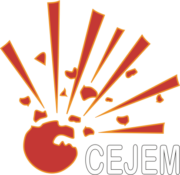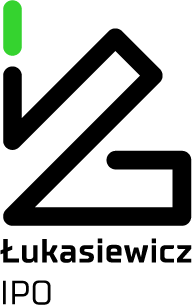
The quarterly Central European Journal of Energetic Materials (CEJEM) accepts original and review papers in all branches of the theory and practice of explosives, pyrotechnics and propellants. It addresses such topics as ignition, combustion and detonation phenomena; formulation, synthesis and processing; analysis and thermal decomposition; toxicological, environmental and safety aspects of production, applications, utilization and demilitarization of energetic materials; molecular orbital calculations; detonation properties and ballistics; biotechnology and hazard testing.
Manuscript Submission
CEJEM offers web-based manuscript submission. Online submission is mandatory. The submissions should not have been published or be being considered for publication elsewhere. Papers should be no longer than 10-15 typed pages (A4), including tables and figures. An Author Contribution Form, which is aimed at preventing ghostwriting and guest authorship, should be attached to every submitted paper. The preferred format is Microsoft Word.doc (WinWord:2003 or higher). Manuscripts accepted for publication will be processed by the journal editors to prepare the final version of the full text. All correspondence concerning the paper’s publication will be by e-mail.
Preparation of manuscripts
- LANGUAGE – papers must be written in English.
- STYLE – the following order is recommended: Abstract, Keywords, Introduction, Materials and Methods, Results and Discussion, Conclusions, Acknowledgements (if necessary), References. However, Authors can chose another format if it is better suited to the content of the paper. The text should be written in a simple, concise and direct style.
- NUMBERING – a manuscript should be submitted as a full text proposed by the Author(s). The manuscript should include separate pages for the literature cited section, tables, figures, photographs, and figure legends. The pages must be consecutively numbered.
- SPACING – double-space everything including text, tables, figure legends, foot notes, and the literature cited section (max. 30 lines per page; font style, Times; size, 12).
- TITLE – the use of small, boldfaced letters is required. The main words should start with a capital letter.
- AUTHOR(S) – provide the full name of each Author (including first name) and their institutional affiliation (complete postal address for all of the Authors and for the corresponding Author, e-mail, fax number and telephone number).
- ABSTRACT – begin the abstract on the title page. The abstract should be written as a single paragraph containing an informative digest of the significant findings (80 to 200 words) and be understandable without reference to the text. The abstract should not reproduce the introductory paragraphs of the paper.
- KEYWORDS – key words should be given under the abstract (maximum five words or short phrases excluding title words).
- ABBREVIATIONS – each non-standard abbreviation should be introduced in parenthesis immediately after the first use of the complete word or phrase.
- MEASUREMENTS AND UNITS – use only SI quantities and units, Arabic numerals for all numbers and for all measurements such as time, weight, length, area, concentration or temperature. Remember to include a space between the number and the unit.
- MATHEMATICAL EQUATIONS – equations should appear in the manuscript where they belong. They should always stand alone, i.e. occupy separate lines. They may be marked with Arabic numerals in parenthesis if cited in the text repeatedly.
- NOMENCLATURE – use systematic names following IUPAC conventions.
- LITERATURE CITATION – citations must be listed in the order in which they appear in the manuscript. All references should be marked in the text as following Arabic numbers in square brackets. The reference number in the text must correspond to the number of the citation in the reference list.The literature cited section should begin on a separate page after the text and before tables and figures. Journal title abbreviations should be those used by Chemical Abstracts and listed in the Chemical Abstracts Service Source Index (CASSI). Journal and book titles should be in italics, the year of publication in boldfaced type, and the volume number of journals in italics. The title of the publication, which must be in English, should be placed after the authors’ names.
Examples:
Journal articles:
[1] Trzciński, W.; Cudziło, S.; Dyjak, S.; Nita, M. A Comparison of the Sensitivity and Performance Characteristics of Melt-pour Explosives with TNT and DNAN Binder.;Cent. Eur. J. Energ. Mater. 2014, 11 (3): 443-455.
Papers in press:
[2] Elbeih, A.; Mohamed, M. M.; Wafy, T. Sensitivity and Detonation Characteristics of Selected Nitramines Bonded by Sylgard Binder. 2016, Propellants Explos. Pyrotech., in press.
Books:
[3] Klapötke, M. T.;Chemistry of High-Energy Materials. 3rd ed., De Gruyter, Berlin/Boston, 2015, pp. 65-99; ISBN 978-3-11-043933-5.
Chapters from multi-author books:
[4] Zeman, S. A Study of Chemical Micromechanism of the Organic Polynitro Compounds Initiation. In:;Energetic Materials;(Politzer, P.; Murray, J. S., Eds.), Elsevier, Amsterdam, 2003, pp. 25-52. ISBN: 978-0-444-51519-3.
Conference Papers:
[5] Matečić Mušanić, S.; Sućeska, M.; Čuljak, R. Study of Ageing Processes of Double Base Rocket Propellants, Based on Stabilizer Consumption. New Trends Res. Energ. Mater., Proc. Semin., 15th, Pardubice, Czech Republic, 2012, 724-734.
Reports:
[6] Bishop, V. J.; James, D. J.;Blast and Fragments from Steel Cylinders Containing Poly-x-75, Poly-x-82, Poly-x-91, Torpex 4D and H6 Explosives, AWRE Report No. 032/73, 1973.
Patents:
[7] Krupka, M.; Moravec, J.; Pachmáň, J.; Šelešovský, J.; Maršálek, R.; Šebesta, V.; Prokeš A. Method of Measurement and Evaluation of the Time History of Sequential Optical Signals Generated by Explosion. Patent CZ 305407, 2015.
Articles in a language other than English: the title should be translated into English (DO NOT translate journal and book titles). The original language should be given in parenthesis immediately after the title.
Example:
[8] Maranda, A.; Wiśniewski, W. Research on the Influence of Aluminum Dust Additives on Detonation Parameters of ANFO Containing Ammonium Nitrate of Low Porosity. (in Polish) Górnictwo Odkrywkowe 1999, 41(4-5), 123-131.
TABLES and FIGURES – Experimental data may be presented in graphical or tabular form, but the same data will not be published in both forms. Data points and relevant equations must be included in the figures. Every table and figure included in the paper must be referred to in the text. Illustrations and figures are required as originals.
Tables− must have a brief title. Tables should be constructed using the table function in Word. Tables should be prepared to fit the page format of the journal (width of the pages is 122 mm). Footnotes in the tables are denoted by a), b), etc., and presented at the bottom of the table. Drawings within a table prepared with ChemDraw or ISIS Draw need to be linked to those programs within the Word file.
Figures − must be numbered with Arabic numerals in the sequence in which they appear in the text. Figure legends are to be listed on an extra page. Multi-part figures should be avoided. The quality of all figures should be such that they can be reproduced directly after reduction to 100 mm width. Numbers, letters, and symbols used must be all roughly the same size and such that they are 1.5 mm high after the figure has been reduced to a width of 100 mm. If the figures are of poor quality, the authors will be asked to provide better original figures, which could lead to a delay in publication. Figures will be printed in black and white. We prefer attached figures as vector graphics (as: EPS, PDF, CDR, AI, WMF).
Legends − each figure and scheme should have a legend. In the final accepted manuscript, the legends should be listed together after the reference section of the text file and not be included with the drawings in the separate graphic files. The position of each equation, figure, scheme, structure or table should be indicated in the text.
Review process
- All communications will be between the corresponding Author and the Editor. Authors can suggest, in the initial e-mail, the names (along with the affiliation and an e-mail address) of 3 (or more) potential Reviewers which may be used at the discretion of the Editor.
- Papers which are assessed by the Editor as suitable for CEJEM will be sent to two independent Reviewers.
- The Editor applies a double-blind review process, which means that neither the Author(s) nor the Reviewers know each other’s identities.
- The corresponding Author will receive the reviews within two months after the submission of the paper (possible delays may result from the Reviewers’ schedule).
- Manuscripts which need content-related corrections (conditionally accepted) must be returned to the Editorial Office as soon as possible but not later than after twelve weeks. Returned papers should be corrected according to the Reviewers’ suggestions or the Author(s) should offer strong arguments as to why the Publisher’s suggestions have been ignored.
Click here to see our Reviewer’s Report Form.
Proofreading
To check the final version of the text, the corresponding Author will receive a proof for correction (sent by e-mail as a *.pdf file). The proof copy should be returned to the Editorial Office within seven working days. All comments should be described in a return e-mail in the following way: page xx, line yy; it is …..; it should be…”. If a corresponding Author does not return proofreading of the manuscript within seven working days, it will be understood that the editorial correction has been accepted without objections.
Materials ownership
Sources of all figures, photographs, tables or other parts of the manuscript that have previously appeared in any publication or are not the property of the Authors must be properly cited in the manuscript. Permission to republish these items must be obtained by the corresponding Author from the person or institution (the publisher) holding the copyright.
The Editor adheres to the Ethical Guidelines for Publication in Journals and Reviews of the European Association of Chemical and Molecular Sciences (EuCheMS). In particular, it has to be stressed that all copyright infringement, especially plagiarism, is an example of serious misconduct in science. Therefore, all submissions will be checked by an anti-plagiarism computer program. A paper which is an entire or partial plagiarism will not be published. Ghostwriting and guest authorship will be also considered as types of scientific misconduct.
Copyright transfer
As a condition of publication the Authors must grant an exclusive license to the Institute of Industrial Organic Chemistry. By signing the Copyright Form the Author(s) transfer(s) and assign(s) all the copyright whatsoever to the Institute of Industrial Organic Chemistry as the Publisher of CEJEM. The Copyright Form must be signed and submitted upon acceptance of the manuscript for publication. Additionally, the Authors agree for the publication of a full text of their submission on the Internet (http://www.wydawnictwa.ipo.waw.pl) simultaneously with its publication in the paper version.
Authors may use their own material in other publications, provided that CEJEM is indicated as the original place of publication and the Institute of Industrial Organic Chemistry is indicated as the publisher.
Before sending your paper, check whether:
- your text is divided into the parts required for a research paper: Abstract, Keywords, Introduction, Materials and Methods, Results and Discussion, Conclusions, Acknowledgements (if necessary), and References;
- full names of all of the Authors and their affiliations, as well as an e-mail address for the corresponding Author, are provided;
- the abstract has the appropriate length (max. 200 words);
- all necessary figures and tables (including titles and footnotes) are provided and contain complete and correct data;
- all equations are correct and all symbols used are explained in the text;
- chemical nomenclature is correct;
- references are in the format required by this journal;
- all references in the text are mentioned in the literature cited section under the same number and vice versa.
Please, check your grammar and spelling as far as you can.
